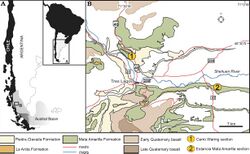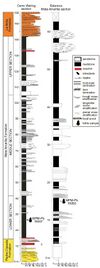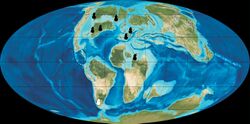Earth:Mata Amarilla Formation
| Mata Amarilla Formation Stratigraphic range: Mid Cenomanian 96.94–95.52 Ma | |
|---|---|
 Map of Mata Amarilla and surrounding formations | |
| Type | Geological Formation |
| Sub-units | Upper, Middle and Lower members |
| Underlies | Alta Vista Formation |
| Overlies | Piedra Clavada Formation |
| Lithology | |
| Primary | Siltstone, claystone |
| Other | Sandstone, tuff, paleosols |
| Location | |
| Coordinates | [ ⚑ ] : 49°30′S 71°30′W / 49.5°S 71.5°W |
| Paleocoordinates | [ ⚑ ] 56°30′S 48°48′W / 56.5°S 48.8°W |
| Region | Santa Cruz Province |
| Country | Argentina |
| Extent | Austral Basin |
The Mata Amarilla Formation is a fossiliferous formation of the Austral Basin in southern Patagonia, Argentina . The formation consists of sediments deposited during the Middle Cenomanian, dated to 96.94 to 95.52 Ma. The middle section of the formation was previously considered to be the Pari Aike Formation.
The Mata Amarilla Formation has provided many fossil vertebrates, among which dinosaurs, fish and turtles, as well as fossil insects, flora and molluscs.
Age
The middle section of the Mata Amarilla Formation has widely been regarded as Maastrichtian in age, but recent dating of a lava tuff layer shows that it dates back to 96.2 ± 0.7 Ma, during the Cenomanian.[1]
Description
The Austral (or Magallanes) Basin, is located on the southwestern end of the South American Plate and it is bordered to the south by the Scotia Plate covering an area of approximately 230.000 square kilometres (88.803 sq mi). In the studied area, the Austral Basin underwent three main tectonic stages: (i) a rift stage; (ii) a thermal subsidence stage; and (iii) a foreland stage.
The rifting stage is related to the break-up of Gondwana, grabens and half-grabens were formed and filled with volcaniclastic and volcanic rocks intercalated with epiclastic sediments of the El Quemado and Tobífera Formations.[2]
Subsequently, the thermal subsidence stage resulted in the deposition of the transgressive quartzose sandstone of the Springhill Formation, and the black mudstone and marl of the Río Mayer Formation. Towards the end of this stage, the Piedra Clavada Formation was deposited, representing a large passive-margin delta system.
The foreland stage, in response to the regional change from extensive to compressive regime, resulted in the deposition of the continental Mata Amarilla Formation. This unit is mainly composed of grey and blackish siltstone and claystone, alternating with whitish and yellowish-grey fine to medium grained sandstone. Varela (2014) recognized three informal sections (lower, middle, and upper) on the bases of sedimentological and sequence stratigraphic analysis. The lower section consists of fine-grained intervals with paleosols interbedded with laminated shale and coquina, representing coastal plain and lagoon paleoenvironments.
The middle section comprises sandstone and siltstone representing meandering fluvial channels and crevasse splay deposits, intercalated with fine-grained floodplains and subordinate lacustrine deposits. The upper section is dominated by fine-grained deposits, related to distal fluvial channels.
Paleosol features and paleosol-derived climatic proxies suggest a subtropical temperate-warm, at 12 ± 2.1 °C (53.6 ± 3.8 °F) and humid, with 1,404 ± 108 millimetres (55.3 ± 4.3 in)/yr, climate with marked rainfall seasonality during the deposition of this unit (Varela et al. 2012b; 2018), in accordance with previous paleobotanical interpretations.[3]
Fossil content
Dinosaurs
| Dinosaurs | ||||||
|---|---|---|---|---|---|---|
| Genus | Species | Location | Stratigraphic position | Material | Notes | Images |
| Austrocheirus | A. isasii | Middle Section | An indeterminate theropod[4][5] | |||
| Clasmodosaurus | C. spatula | Middle Section | ||||
| Loncosaurus | L. argentinus | Middle Section | ||||
| Orkoraptor | O. burkei | Middle Section | ||||
| Puertasaurus | P. reuili | Middle Section | ||||
| Talenkauen | T. santacrucensis | Middle Section | ||||
Other vertebrates
- Ceratodus iheringi
- Lepidotes sp.
- Chelidae indet.
- Elasmosauridae indet.
- ?Docodonta indet.[6]
- Ausktribosphenidae indet.[6]
- Amarillodon meridionalis[6]
- Treslagosodon shehuensis[6]
Molluscs
- Glyphea oculata
- Anagaudryceras cf. politissimum
- Baculites cf. kirki
- Polyptychoceras (Polyptychoceras) sp.
- cf. Potamides sp.
Insects
- Aonikenkissus zamunerae[7]
- Myrcia acutifolia
- M. santacruzensis
- Zygadenia sp.
Flora
- Arcellites disciformis[8]
- Bignonites chalianus
- Fitzroya tertiaria
- Laurophyllum kurtzi
- ?Schinopsis dubia
- Equisetites sp.
- Phylites sp.
References
- ↑ Varela et al., 2012
- ↑ Santamarina et al., 2018, p.608
- ↑ Santamarina et al., 2018, p.609
- ↑ Ezcurra et al., 2010
- ↑ Rauhut, 2012
- ↑ 6.0 6.1 6.2 6.3 Martin, T.; Goin, F. J.; Schultz, J. A.; Gelfo, J. N. (2021). "Early Late Cretaceous mammals from southern Patagonia (Santa Cruz province, Argentina)". Cretaceous Research 133: 105127. doi:10.1016/j.cretres.2021.105127.
- ↑ Cerro Waring at Fossilworks.org
- ↑ Santamarina et al., 2018, p.610
Bibliography
- Santamarina, Patricio E.; Viviana D. Barreda; Ari Iglesias, and Augusto N. Varela. 2018. Salvinialean megaspores in the Late Cretaceous of southern Patagonia, Argentina. Acta Palaeontologica Polonica 63. 607-616. Accessed 2019-10-13.
 Material was copied from this source, which is available under a Creative Commons Attribution 4.0 International License.
Material was copied from this source, which is available under a Creative Commons Attribution 4.0 International License. - Rauhut, O.W.M. 2012. A reappraisal of a putative record of abelisauroid theropod dinosaur from the Middle Jurassic of England. Proceedings of the Geologists' Association 123. 779–786. Accessed 2019-10-13. doi:10.1016/j.pgeola.2012.05.008
- Varela, A.N.; D. G. Poiré; T. Martin; A. Gerdes; F. J. Goin; J. N. Gelfo, and S. Hoffmann. 2012. U-Pb zircon constraints on the age of the Cretaceous Mata Amarilla Formation, Southern Patagonia, Argentina: Its relationship with the evolution of the Austral Basin. Andean Geology 39. 359–379. Accessed 2019-10-13. doi:10.5027/andgeoV39n3-a01
 available under a Creative Commons Attribution 4.0 International License
available under a Creative Commons Attribution 4.0 International License - Ezcurra, M.D.; F.L. Agnolin, and F.E. Novas. 2010. An abelisauroid dinosaur with a non-atrophied manus from the Late Cretaceous Pari Aike Formation of southern Patagonia. Zootaxa 2450. 1–25. Accessed 2019-10-13. doi:10.11646/zootaxa.2450.1.1
Further reading
- J. F. Petrulevicius, A. N. Varela, A. Iglesias, A. B. Zamuner, and D. G. Poiré. 2014. First Cenomanian record of insects in the southern Hemisphere, with Perforissidae (Fulgoroidea) and Cupedidae (Coleoptera) from southern Patagonia, Argentina. Cretaceous Research 51:174-185
- J. P. O'Gorman and A. N. Varela. 2010. The oldest lower Upper Cretaceous plesiosaurs (Reptilia, Sauropterygia) from Southern Patagonia, Argentina. Ameghiniana 47(4):447-459
- A. Iglesias, A. B. Zamuner, D. G. Poiré and F. Larriestra. 2007. Diversity, taphonomy, and palaeoecology of an angiosperm flora from the Cretaceous (Cenomanian-Coniacian) in southern Patagonia, Argentina. Palaeontology 50(2):445-466
- F. J. Goin, D. G. Poire, M. S. De Fuente, A. L. Cione, F. E. Novas, E. S. Bellosi, A. Ambrosio, O. Ferrer, N. D. Canessa, A. Carloni, J. Ferigolo, A. M. Ribeiro, M. S. Sales Viana, M. A. Reguero, M. G. Vucetich, S. Marenssi, M. F. Lima Filho and S. Agostinho. 2002. Paleontologia y geologia de los sedimentos del cretacico superior aflorantes al sur del rio shehuen (Mata Amarilla, Provincia de Santa Cruz, Argentina). Actas del XV Congreso Geologico Argentino, El Calafate, 2002 1-6
- M. B. Aguirre Urreta. 1989. The Cretaceous decapod Crustacea of Argentina and the Antarctic Peninsula. Palaeontology 32(3):499-552
- J. Frenguelli. 1953. La Flora Fósil de la región del Alto Río Chalia en Santa Cruz (Patagonia). Paleontología. Notas del museo XVI(98):239-257
- F. Ameghino. 1899. Nota preliminar sobre el Loncasaurus argentinus un representante de la familia de los Megalosauridae en la República Argentina [Preliminary note on Loncasaurus argentinus, a representative of the family Megalosauridae in the Argentine Republic]. Anales de la Sociedad Científica Argentina 47:61-62
 |







